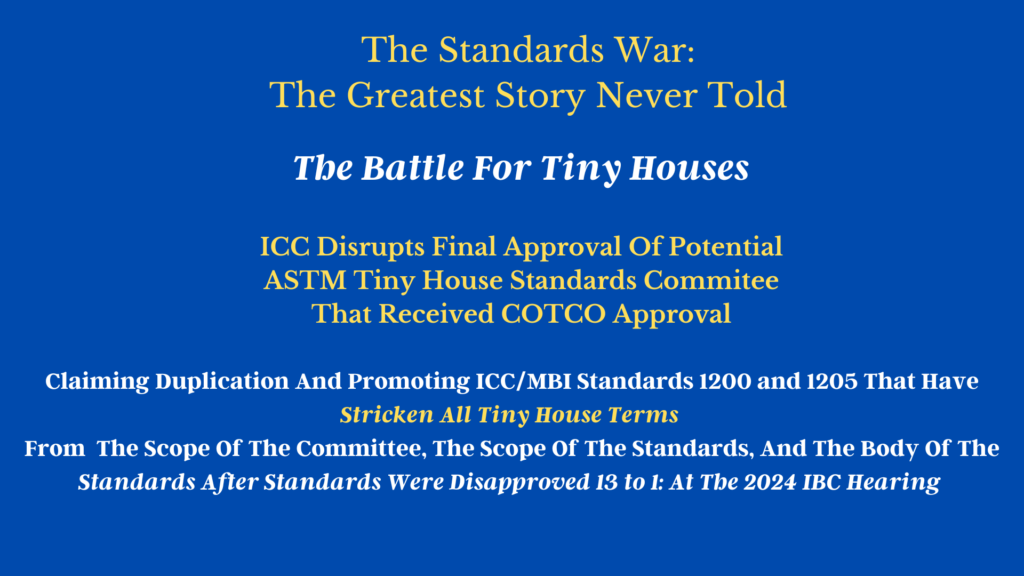The Battle For Tiny Houses
There has been a secret standards war raging in the undercurrents of the tiny house industry that I will not be silent about anymore. For almost two years I have written with diplomacy and tried to take the high road no matter what was going on. There is too much at stake to be silent now. We have been fought by both corporate and special interest groups.
This is going to be a long read-so I will try and summarize the points ahead of time as much as I can, and you can decide if you want to dig deeper and read the entire article.
A tiny house on wheels do not have its own standard. Most often they are built to RV standards, then RVIA must lobby against the industry if tiny houses on wheels are associated with housing. Learn more.
We have been working with ASTM International for over a year and a half with the goal of being granted a committee to develop and maintain standards specific to tiny houses. We received unanimous approval from COTCO, the ASTM board that grants new technical committees. Learn More.
At the same time, we received COTCO approval, we also received the news that the International Code Council (ICC) had sent an objection letter to ASTM regarding the committee. We have been stalled now for almost 5 months. During this time, ICC has written Model Legislation for tiny houses. Learn More.
I will also address the ICC off-site and modular construction standards committee that developed two standards for modular construction, ICC/MBI 1200 ad 1205. Tiny houses were first excluded, then included, and then all tiny house terms were deleted after the disapproval at the 2024 IBC hearing. ICC has stated that tiny houses do not have to be called out because they are ”inclusive.” Learn more.
We have two states, Colorado and New Hampshire, that endorsed the ASTM tiny house committee, and were poised to reference the standards before they were even written, but we have had a cloud of opposition over this initiative that has not allowed us to progress to the real work that needs to be done.
If you are a manufacturer, or even an end user, it is important that you read this post. There are those trying to steer the industry on a path that serves their agendas, not toward a path that benefits the industry as a whole. This will greatly increase the cost of tiny houses.
ICC is trying to broadly sweep tiny houses under either Modular construction or the Manufactured Home HUD code.
We are desiring to introduce a third option, a uniform construction standard for tiny houses on wheels that will result in a new classification for tiny houses on wheels, not an RV, not a modular, not a Manufactured Home. The entire tiny house industry is invited to participate in the ASTM tiny house initiative. Learn more.
We need to cultivate and celebrate all legal paths for tiny houses and work as a united industry.
Where Is The Tiny House Industry Headed?
If you have a vested interest in the industry, and you want to not only know where the industry is going but also influence the direction, read on.
The two main 3rd parties that certify tiny houses cannot meet the requirements of what ICC is pushing for tiny houses in the ICCMBI 1205 standard and if you are a new manufacturer, it will be quite expensive to have your initial plant inspection.
ICC 1205 draft ballot approved:
Standard for Off–Site Construction: Inspection and
Regulatory Compliance
7/01/2021: Link
ICC 1200 draft ballot approved:
Standard for Off–Site Construction: Planning, Design,
Fabrication and Assembly
7/01/2021: Link
‘The initial plant certification shall require 100 percent inspection of the aspects of construction on not fewer than one module or modular component and verify that the manufacturer has a functioning quality assurance process. This inspection shall be made by one or more qualified engineers who have reviewed the approved design and by a qualified inspector. If the initial module or modular component fails to conform with the design or standard, additional modules or modular components shall be inspected until the third-party agency is satisfied that the manufacturer complies to the approved design, the standards and the quality assurance manual. ‘
Note: If you ship to numerous states, you will need to have quality assurance for each state you ship to, because the unit must comply to the state and local building codes and regulations.

ASTM Tiny House Committee
As many of you know, we have been working with the ASTM International, the largest ANSI Accredited Standards Developer in the world and were granted a new tiny house committee by COTCO, the board that grants new technical committees, in February 2022.
This is an opportunity where the entire tiny house industry is invited to develop standards specific to our industry. No one can be left out and the million dollar company does not have a voice greater than the end user, they have one vote. We would elect officers, create our own committees and pick the experts of the industry that have the specific technical expertise to be on the task groups that write the standards. The committee would develop and maintain the standards for life.
We are NOT trying to exclude additional methods of construction for tiny houses or create THE EXCLUSIVE METHOD.
We received word from Lissy Velez, the program manager with the new business development team with ASTM International that COTCO has approved a new ASTM Tiny House Standards Committee.
We will have one more final approval from the ASTM International board.
Janet Thome, the President of Tiny House Alliance USA has been leading this initiative.
We have one last step to be approved by the ASTM International board.
No State Or Local Agency Has Specific Statutory Or Regulatory Definition Authority Of Construction Approval For Tiny Homes As A Speciality Product
In California, a tiny home is subject to comply with either the California Building Codes or:
- HUD Code Manufactured Home
- California Residential Code
- Factory Built Housing ( Modular)
- Recreational Vehicle
- Park Model
- Camping Cabin

The ICC Objection
On the same day we received the news that COTCO approved a new committee for tiny houses, we received news that ICC was objecting to our committee.
ICC states that they feel they have covered everything for tiny houses, including tiny houses on wheels because of Appendix Q Tiny House, the IRC AQ Tiny House ( 2021 ) and the 2 ICC/MHI standards 1200 and 1205. ICC also states that they have covered plan review, inspection, quality assurance, certification, and labeling as well. One of ICC’s subsidiary feels that another standard for a residence is not needed. We are hoping to have a conclusion to their objection and find a collaborative path to work together.
After months of debate, we have decided to re-submit our tiny house proposal to COTCO, to address the objection at the advice of the ASTM executive team.
Learn More: ICC Objects To ASTM Tiny House On Wheels Standard
We Cultivated A Spirit Of Collaboration With ICC Early On
To avoid duplication, or a conflict of interest, and to cultivate a spirit of collaboration, I personally reached out to ICC very early in our initial negotiation with ASTM and also made ASTM aware of the ICC Off-Site And Modular Construction Standards Committee that were developing two standards;
ICC/MBI 1200 Standard for Off-site Construction: Planning, Design, Fabrication And Assembly
1CC/MBI 1205 Standard for Off-site Construction: Inspection, Regulatory Compliance
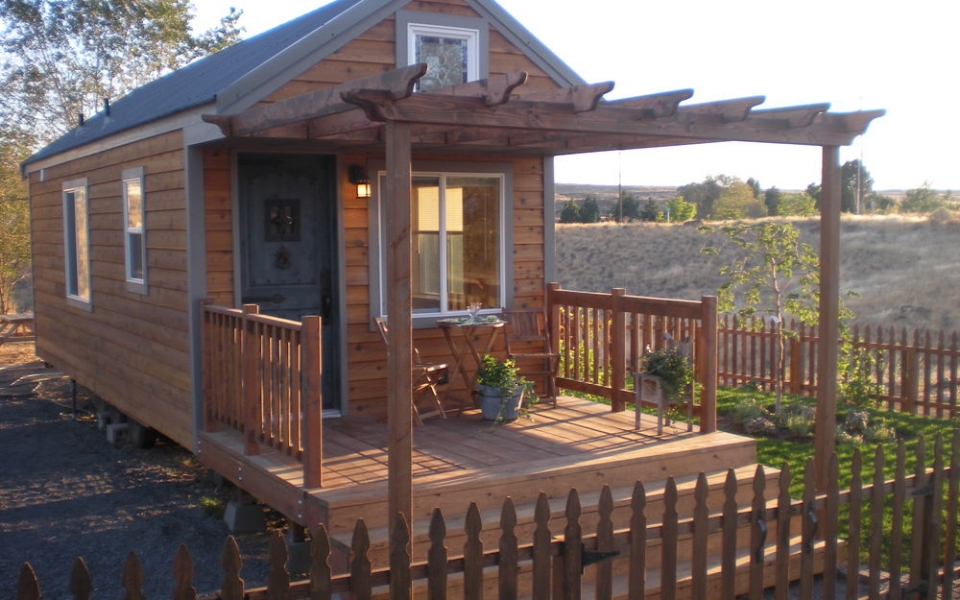
At the time of our initial discussion with ICC, tiny home terms were included in the scope of the committee, the scope of the standards, and the body of the standards. I was never concerned that there would be a conflict, because the tiny homes would be built to Modular Construction which is built off-site and must comply to model building codes to where the tiny house would be transported to. We had several calls with ICC.
March 9th, 2021: Leonard Morrissey, Lissy Velez, Janet Thome, Bob Gorleski, and Mark Johnson, the ICC/ASTM liaison had a call and introduced our ASTM committee and a primary goal to develop a tiny house on wheels standard.
August 2021: Lizzy Velez spoke to Karl Aittaniemi, the ICC Director Of Standards- regarding the THIA objection and the subject of duplication sometime in August.
Sept 1st, 2021: Leonard Morrissey, Lissy Velez spoke to Karl Aittaniemi and Mark Johnson with ICC regarding the THIA objection and also to understand the position of ICC and our ASTM committee.
Mark Johnson attended the second call with the stakeholders.
Nov. 8th 2021: ICC was invited to the organizational meeting on approving the proposal to be presented to COTCO. They did not attend the meeting to vote.
During the initial phase of the ASTM negotiation, I spoke to both Karl and Mark to make sure I understood how to not be in conflict with the codes, and I received supportive information and I was instructed on how to complement and supplement the code, including Appendix Q Tiny House. Karl spoke of collaboration in case in the future, potential standards would be referenced in the codes that would require mandatory language.
Two members on the board of the Tiny Home Industry Association ( THIA ) are also on the ICC Off-Site And Modular Standards Committee. Alot of the ICC objection is a recycled version of the THIA objection. The THIA objection delayed us for 4 months. Part of the THIA objection was because they stated they were going to submit an I-Code amendment for Appendix Tiny House for the 2024 IRC. They did not end up submitting the amendment.

Thom Stanton, Tiny House Advocate Was The Lead On The Virginia Task Group For
Appendix AQ Tiny House Inclusion Of Virginia Uniform Building Code. Thom Was Also The First President Of THIA. Thom has endorsed The Potential ASTM Tiny House Standards
Notable Members Of Tiny Home Industry Association ( THIA)
After Leaving THIA, both Janet Thome and Thom Stanton were considered Noatable Members of THIA.


Janet Thome Advocate And Founder Of Tiny Portable Cedar Cabins
Janet Thome sponsored the relaunching of THIA’s online presence in 2019. She served on the board as the THIA Industry Liaison and Media Coordinator from June 2019 to Oct 2020. She remains a dedicated advocate for tiny homes and is a Guest Editor For THIA. Lloyd Mabuto with Final Touch Labs graciously sponsored the rebuilding of the THIA website and donated an amazing amount of time, patience, and beautiful smiles to the project.
Janet Thome is the founder of Tiny Portable Cedar Cabins. After being a tiny home consultant for one builder of tiny homes, she has changed the model of her business to fulfill the needs of the customers who were needing tiny homes, nationwide and represents builders all across the country.
Janet loves to connect the consumer with their design choices, where to live legally, insurance, financing, grants, and most of all, a customer’s dream of owning a tiny home. Janet has a small tiny home village in Washington state and LOVES dogs. She has a blog and writes extensively regarding tiny homes.
Janet is the Founder and President of Tiny House Alliance USA.
Thom Stanton The First President Of THIA
Thom and Midge Stanton live full-time in their DIY-built 90 sqft tiny house alongside the Blue Ridge Parkway in the mountains of Virginia. Together the couple runs GoTiny, a home design, and planning company focused on developing kit-based housing solutions. Thom is President Emeritus for the Tiny Home Industry Association, State Chapter Leader for the American Tiny House Association, a frequent panelist at housing events, and guest speaker at tiny home festivals. Thom leads the Uniform Compliance Initiative for Tiny Homes and is actively participating in standards development efforts for Off-Site Modular Construction and community planning projects focused on increasing the availability of safe, efficient, and affordable housing.
Both Janet Thome’s and Thom Stanton contributions were removed from THIA’s Notable Members Page after Janet initiated the potential standards development with ASTM and after Thom endorsed the initiative.
International Building Code Hearing ( IBC )
The 2 ICC/MBI Standards 1200 and 1205 developed by the ICC Off-Site And Modular Construction Standards Committee (IS-OSMC) were disapproved at the IBC 2024 hearing and one reason was because tiny homes were included in the standards.
Currently all tiny house/home terms have been stricken from the scope of the committee, the scope of the standards, and the body of the standards. The committee blamed the disapproval on the tiny home terms, but actually Tom Hardiman, with the Modular Housing Institute and co-chair of IS-OSMC that presented at the hearing, stated he did not know how to answer the questions regarding tiny homes, and no one from the tiny house industry was present to answer the questions.
The standards were not well received by the code council. The code officials also stated the code has already covered many aspects that the standards were addressing. The definitions are too broad for off-site modular components. Precast elements are already addressed in the code. One commenter saw conflicts with certification already addressed in the code.
Micah Chappell City Of Seattle, State Building Code Council was the first to make a motion to disapprove the standards, he stated;
‘’ IRC Appendix Q is not required to be adopted by states or it is not required to be used, and tiny house is not defined in the IBC. This proposal would take the tiny house, which is just a dwelling unit, and take the review and application requirements of that dwelling unit and push it to a standard.
I do not agree with that. When we are talking about tiny houses and Appendix Q, they are very specific, but there are two criteria here that are not defined, a tiny house on wheels, or a tiny house like the other modular buildings where it is possibly driven in and then craned onto a foundation. So blanket items for tiny houses, I do not agree with. ‘’
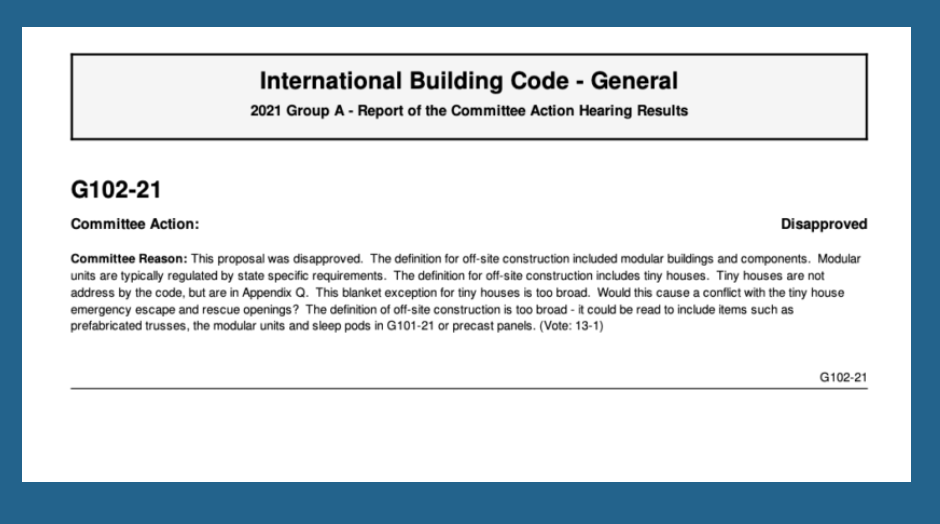
After the IBC hearing, the committee decided to remove all tiny home terms, along with Appendix AQ Tiny House from the scope of the committee, the scope of the standards, and from the body of the standards 100% with the theory that there was no need to call out tiny houses, because they were ”inclusive”.
Reasons For Disapproval At The IBC Hearing
- The definition for off-site included modular buildings and components. Modular units are typically regulated by state specific requirements.
- The definition for off-site construction includes tiny houses. Tiny houses are not address by the code, but are in Appendix Q.
- This blanket exception for tiny houses is too broad.
- Would this cause a conflict with the tiny house emergency escape and rescue openings?
- The definition of off-site construction is too broad-it could be read to include items such as prefabricated trusses, the modular units and sleep pods or precast panels.

In ICC/MBI Standards 1200 and 1205- Tiny homes were first excluded, then included, and because the proposal was voted down by the code council, all terminology of tiny homes has been stricken.
Reason: This Committee proposal deletes all mention of tiny homes in the ICC 1200 & 1205
Standards. Requirements for tiny homes are adopted by the AHJ, and should not be mandated by the Standards. AHJ may adopt IRC Appendix Q, but they may not. This will leave that decision up to them and not require it when the Standards are adopted.
Follow The History Of Tiny Homes In ICC/MBI 1200 and 1205 Standards
Unifying Terms In Standards Is Key For Success
When we received unanimous COTCO approval, Cesar Constantino added a comment.
‘The term ‘’tiny’’ as used in the Committee did make me pause. Terminology and definition will be essential to quickly and adequately provide context. Thank you- CAC.
We Could Not Agree With Cesar More
When Tom Hardiman, the co-chair of IS-OSMC was giving his opening remarks at the IBC hearing for 1200 and 1205 to be inclusive in the codes last year he mentioned there are 35 state agencies that have modular programs, and the 15 states that do not have a program, the local code official is the authority having jurisdiction ( AHJ ) for their projects.
He said ”You Could Imagine That Leaves Compliance And Quality Control Open To A Thousand Interpretations.” Tom mentioned that the goal was to gain uniformity.
Uniformity is the same goal that the tiny house industry has and the logic that tiny houses are inclusive in 1200 and 1205 without mentioning tiny house terms in the standards compounds the thousand interpretations times a thousand fold.
How many code officials, legislators, manufacturers, or consumers would interpret ICC/MBI standards 1200 and 1205 that would conclude tiny houses are ‘’inclusive’’?
One of the keys to writing standards with the goal of uniformity, is to establish agreed upon terms.
ICC/MBI Standards 1200 And 1205-Limitations Applied To Tiny Houses
- Both ICC/MBI standards are American standards meant to be adopted by jurisdictions in the US. The ASTM Tiny House initiative is international.
- Both standards are administrative in nature. Modular still must meet relevant building codes. The standards are also Off- Site Specific. We represent a lot of stakeholders who are do it yourselfers and have or will build their own tiny house on site. See ICC Off- Site Codes Working Group. Our ASTM activity would cover both on and off-site specifics.
- There is a limitation with the IRC, because the states are at different levels of ICC code adoption. You may have one state that’s on the 2009 codes, one that’s on 2015, and some that have adopted the 2018 or 2021 codes. There are also states that have their own codes. See International Codes-Adoption By State ( Jan 2022). Jurisdictions may or may not adopt codes and standards at the local level or will exclude an appendix. Appendix Q Tiny House ( 2018 IRC) and Appendix AQ Tiny House ( 2021) are not mandatory.
- Modular construction is one method of construction and is not an affordable solution for tiny houses on wheels because of the cost of all the required plans for each structure and the chassis, including architectural, mechanical, electrical, plumbing (mep) structural, and civil if attached to the soil.
- The tiny house industry does not desire to be broadly swept under modular construction and to be considered ‘’inclusive’’ by the ICC Off-Site And Modular Construction Standards Committee which lacks adequate representation of a broader group of stakeholders.
- There is a global housing crisis, and we need every viable solution that exists for housing. The ICC is not a regulatory body for a vehicular unit that is regulated by DOT and NHTSA, which applies to US regulations.
- ICC does not have the power or authority to police or enforce compliance with the contents of this standard. Only the governmental body that enacts this standard into law has such authority. The highlighted statement is directly from ICC-yet ICC is trying to enforce tiny houses to be in compliance with both standards against the will of a large portion of the tiny house industry that desires to develop standards specific to tiny houses with ASTM International and stakeholders in the tiny house industry.
- See statement under Maintenance- submittal of approval.
- The ICC codes and standards state they do not preclude other practices or methods of construction.( The ICC Objection is a contradiction to this statement) .
- Industrialized Housing: the standards define Industrialized Housing as- a residential structure that is designed for the occupancy of one or more families; is constructed in one or more modules, or constructed using one or more modular components, built at a location other that the permanent site; and is designed to be used as a permanent residential structure when the module or modular component is transported to the permanent site and erected or installed on a permanent foundation system. ( The potential ASTM standard for tiny houses on wheels will not be classified as an industrialized house or building that will comply to model building codes. In the US, it would be a vehicular unit that would comply to DOT,NTHSA regulations, and possibly regulated by HUD in the future. A tiny house on wheels could also be permanent or at a temporary location to be moved again).
- Off-Site Construction: The standards define off-site construction as- a modular building, modular component or panelized system that is designed and constructed in compliance with this standard and is wholly or in substantial part fabricated or assembled in manufacturing plants for installation—or assembly and installation—on a separate building site and has been manufactured in such a manner that all parts or processes cannot be inspected at the installation site without disassembly, damage to, or destruction thereof. ( The potential ASTM standard for tiny houses on wheels will not be designed or constructed in compliance to the ICC/MBI standards. )
- Compliance Alternative: The standards state- nothing in this standard is intended to prevent the use of designs, technologies or products, including listed and labeled modular components as alternatives to any prescriptions in this standard, provided that equivalence is demonstrated and approved by the author ity having jurisdiction. Listed and labeled modular components shall be installed in accordance with its listing, the manufacturer’s installation instructions and the applicable requirements of the construction codes adopted by the authority having jurisdiction. ( The ICC objection is preventing alternative and new methods for tiny houses ).
- Provisions that do not necessarily increase construction costs– ( We disagree with this statement in the standards, tiny houses built to modular construction, will raise the price.)
- Provisions that do not restrict the use of new materials, products or methods of construction- ( The ICC objection is trying to restrict a new method of construction and product).
- Provisions that do not give preferential treatment to particular types or classes of materials, products or methods of construction-( The ICC objection is trying to restrict a new classification and is promoting preferential treatment to tiny houses only built to Modular construction and or the HUD Manufactured Home And Safety Standards).
Chapter 1-Application And Administration ICC/MBI 1205
SECTION 101: Administrative Provisions
101.1 Purpose. The purpose of this standard is to provide minimum requirements to safeguard public health, safety and general welfare and to address societal and industry challenges for the inspection and regulatory compliance of off site construction. This standard is intended for adoption by government agencies and organizations for use in conjunction with model codes to achieve uniformity in the inspection and regulatory compliance of off-site construction.
( The potential ASTM standard for tiny houses on wheels will not comply to model building codes. Certification has already been established in 38 states by the authority having jurisdiction (AHJ) and they and may or may not adopt this standard ).
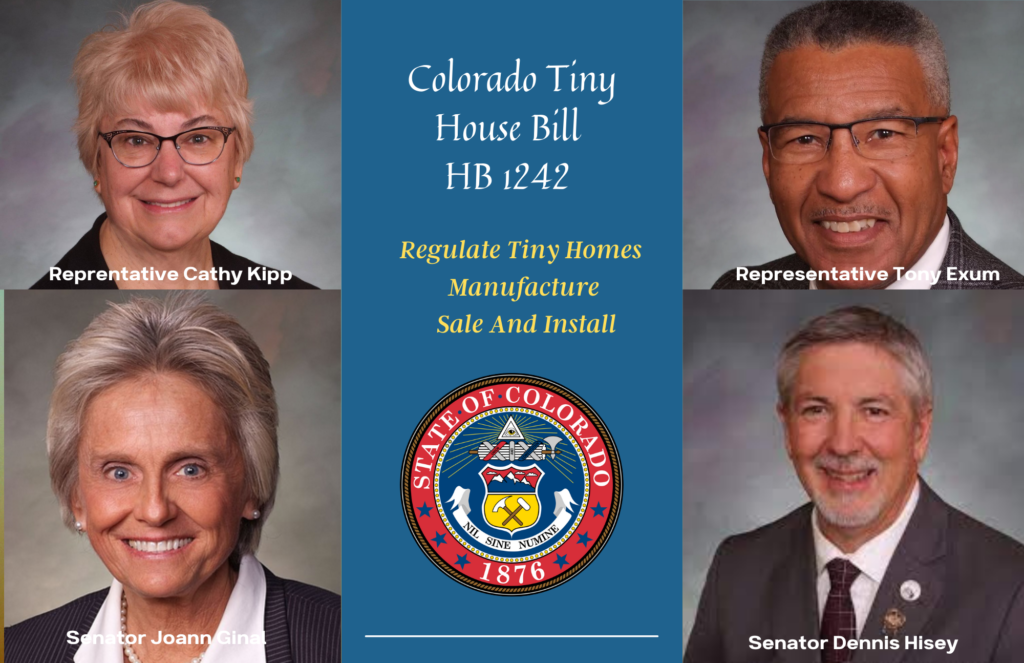
The ICC Objection Coincided
With The Colorado Tiny House Bill
The ICC objection was sent to ASTM International on Feb.4th, 2022, a few days after stakeholders had 2 calls with Colorado legislators and building officials that were discussing a brand new tiny house bill. The bill was written to create an advisory council to suggest rule making for a new state program and adopt new standards for tiny houses on wheels as a residence and hooked up legally to utilities long term. It is important to note that Colorado has a state program for Modular construction and manufactured homes.
They had an understanding that tiny houses need to be their ‘’own thing.’’
On the call, the ASTM potential tiny house standards had verbal support from RVIA and Eric Fried, the Chief Building Official of Larimer County, Colorado whom initiated the tiny house bill, and said ‘’ ASTM was the best long term path forward’’.
Excerpt From Eric Fried’s Letter Of Support:
Some may argue that no ASTM standard is needed or that ICC’s International Residential Code (IRC) should be THE standard for Tiny Houses. Nothing could be further from the truth. As you no doubt know, the IRC’s prescriptive standards for footings and foundations have no place for Tiny Houses on Wheels and only apply to wood, masonry, and concrete foundations with footings placed below the frost depth of the locality. IRC voluntary Appendix Q for Tiny Houses does not address structural concerns such as footings, foundations or framing at all, only ceiling height, lofts, stairs, egress windows and energy efficiency. With no IRC rules, each Tiny Houses on Wheels would need an engineered foundation system and/or its wheels removed and placed on a conventional foundation.
Eric Fried’s Letter Of Support
Video Of Colorado Tiny House Bill
Rep. Cathy Kipp Endorses ASTM Tiny House Committee
Rep Chris Kennedy Endorses ASTM Tiny House Committee
Lissy Velez Was A Guest Presenter At The Colorado Energy Environment
The Colorado Tiny House bill goes into effect on August 10th, 2022 and lists ASTM International as a potential standard to reference, along with ICC and NFPA for tiny houses on wheels.
Right after the calls with Colorado, I was informed that ICC went to the state of Colorado and first said they were going to boycott the bill, then they suggested for the IRC to be listed in the bill as law, to avoid rule making which would have eliminated the potential ASTM tiny house standards.
Colorado did not agree to ICC’s request.
The ICC Model Legislation
On May 4th, 2022 ICC published new Model Legislation For Tiny Houses that was written by THIA and ICC to promote compliance to IRC codes and the two ICC/MBI standards 1200 and 1205.
The standards state:
The use of American National Standards is completely voluntary; their existence does not in any respect preclude anyone, whether they have approved the standards or not, from
conforming to the standards unless compliance with the standard is required by law instituted by a governmental body.
As our committee sits stalled, ICC and THIA are promoting the standards to become law, instead of voluntary, to restrict trade and preclude new methods of construction for tiny
Houses.
Conflicts Of Interest In The Model Legislation For Tiny Houses
- Written by a subsidiary of ICC that is stating tiny houses must comply with standards ICC developed
Authored by ICC subsidiary staff that was the chair of the ICC Off-Site And Modular Construction Standards Committee
The Author was also the task group leader for Accreditation that wrote requirements at the maximum level, instead of the minimum leaving out one of the most popular 3rd parties that
certify tiny houses.The Author is also on the board of THIA
The Co-Author is also on the board of THIA
The Co-Author was also the only company that represented tiny houses at the ICC Off-Site Committee
The ICC claims that they have covered everything for tiny houses to us and to ASTM, including tiny houses on wheels yet in their own words, there are more requirements as stated in the model legislation:
‘While design and construction requirements are tied to the IRC, tiny houses with a chassis and wheels may also be subject to additional requirements to support their transportation.
In this case, additional certifications may be required.’
What I find interesting is that ICC has claimed to us and ASTM that tiny house terms are NOT needed in ICC/MBI 1200 and 1205, because they rationalize that tiny houses are inclusive of modular construction and do not need to be called out. But yet………they have to produce another supportive document-model legislation that adds the tiny house terms back so an authority having jurisdiction will understand that tiny houses are inclusive without the tiny house terms in the standards.
” ICC is not going to LET ASTM create a standard that describes how to build a residential dwelling unit. I think we’d all like to avoid an ugly fight. ”
The above text is from a subsidiary of ICC that told me in an email that ICC was not going LET ASTM create a standard that is a residence. So here we are, stalled.
After I finally revealed the ICC objection and all the conflicts of interest I saw in the Model Legislation, and shared my answer to the ICC objection to the ASTM stakeholders, I was warned that I was close to a libel suit. Wow——
So ICC has a whole host of services, facilitates the building code process, develops standards, and then writes Model Legislation for compliance to their own codes and standards, and warns of a libel suit if you question it, while disrupting the Colorado opportunity and trying to kill the ASTM tiny house committee!
That is a pretty closed loop since the ICC has not been friendly toward tiny houses on wheels in the past.
ICC Did Not Allow Tiny Homes On Wheels In The Initial Proposal Of Appendix Q Tiny House That Was Approved For Inclusion To The 2018 IRC.
From Andrew Morrison, Co-Author Of Appendix Q Tiny House
I had to make some last minute changes to the proposed code language to remove the word “moveable” from my original proposal entitled “Movable Tiny Houses.” Unfortunately, the head of the ICC code approval process said that he would not accept the proposal as written because he believed it was what they call in the industry a “hijack” of the original proposal.
After many conversations and emails with the official, I decided to amend the proposal so that he would allow it to move forward. After all, when he said “if you keep the moveable details in there, I will throw the whole thing out” it became crystal clear what my options were.
Source Washington Tiny House Association: So What Exactly Is Tiny House Appendix Q?

Why Tiny Houses Cannot Be Broadly Swept Under HUD or Modular Only
This map is further proof why tiny houses on wheels in particular cannot be broadly swept under modular construction and the 2 ICC/MCI standards 1200 and 1205, especially without specific tiny house terms because of the 14 states the map lists that are unfriendly to modular, some ARE FRIENDLY, to tiny houses, especially to tiny houses on wheels, such as;
New Hampshire: Is listed as an unfriendly state toward modular. However State Representative Jim Maggiore, who is also a planner in the Hamptons, was on the June 24th, 2022 call with ICC and ASTM and endorsed the ASTM tiny house committee. He has also expressed the need for the tiny houses on wheels standard and killed his own tiny house bill after Nick Rudowich, Government Relations for RVIA made him aware of the potential committee and ASTM tiny house standards.
Excerpt From Rep. Jim Maggiore’s Letter Of Endorsement;
In New Hampshire, a study committee was formed in 2019 to review the issues creating comprehensive standards for tiny homes on wheels. Legislation from that committee was tabled by the full Senate in 2020. Legislation was filed again in 2021 but failed in House committee.
After careful study and review, I co-sponsored yet another bill this year to advance building codes for tiny homes on wheels only to kill the bill myself in my own House committee due to defects in the proposed standards.
The people of New Hampshire are eager for ASTM International to help us and people across the country make tiny homes on wheels a viable option for affordable, safe home ownership. The standards set by ASTM International for tiny homes on wheels will conclusively settle issues such:
- Definition of a tiny home on wheels;
- Standards for foundations for tiny homes on wheels;
- Settling whether a tiny home on wheels is personal property or real property;
- Certification for plan reviews, inspections, and registrations;
- Address utilities and wastewater:
Rep. Jim Maggiore’s Letter Of Endorsement
Maine: Is listed as as unfriendly toward modular, but Maine is leading the way toward opening doors in the marketplace for tiny houses on wheels to be titled and lived in as a primary dwelling built to RV standards and have passed two tiny house bills into law.
Maine-An Act To Allow Tiny Homes As A Primary Dwelling Maine LD1530
This bill establishes standards for municipalities to follow regarding tiny homes, which are structures no larger than 400 square feet constructed on a frame or chassis and designed for use as permanent living quarters. The bill allows municipalities to set rules for tiny homes that are less restrictive than state law, allows tiny homes on undeveloped and developed housing lots, allows municipal inspection of certain features of tiny homes and provides for tiny homes.
Maine-A Act To Allow Tiny Homes As A Primary Dwelling
An Act Regarding The Regulation Of Tiny Houses LD 1981
”An Act Regarding The Regulation Of Tiny Houses ”
LD 1981, sponsored by Senator Michael Carpenter was signed by Governor Janet T. Mills Brown on March 18th, 2020. This bill proposes to define what a tiny house is and to allow for the titling of a tiny house as a camp trailer or a trailer.
80-C. Tiny home. “Tiny home” means a living space permanently constructed on a frame or chassis and designed for use as permanent living quarters that:
A. Complies with American National Standards Institute standard A 119.5 on plumbing, propane, fire and life safety and construction or National Fire Protection Association standard 1192 on plumbing, propane, and fire and life safety for recreational vehicles;
B. Does not exceed 400 square feet in size;
Maine Regulation Of Tiny Houses
Idaho: is listed as unfriendly toward modular construction, though once again, it is NOT the same for tiny houses on wheels. Blaine County, Idaho County Commissioner Dick Fosbury contacted one of our stakeholders that was promoting the potential ASTM committee for tiny houses. Dick is a champion for tiny houses and was very familiar with ASTM. We have been crippled by delays because of THIA and ICC which has halted our ability to get down to the real work needed for the industry-so this county had to reference a DeFacto Standard.
Blaine county just signed ordinance NO. 2022-03 in May 2022 to allow tiny houses on wheels that would be allowed as a residence to be built to the NOAH ANSI + Standard that is basically a non official Defacto Standard using the base of the Park Model Standard ANSI 119.5 and the + addresses climate considerations in Blaine county.
The ordinance states: Whereas the county wishes to regulate these units because tiny homes on wheels do not meet building codes as dwelling units;
Blaine County, Idaho Opens Doors For Tiny Houses On Wheels
Colorado is listed as neutral to Modular but as as I expressed before, they are creating a state program for tiny houses on wheels and ASTM international is listed in the potential standards that could be adopted.
Why Not Cultivate All Paths To The Legalization Of Tiny Houses
I am not writing any of this for people to pick sides. I am writing this because there should NOT be sides. ICC wants tiny houses to be built to Modular construction which must comply to the local building codes to where the tiny house is shipped to, or the HUD code.
That is great, but do not try and eliminate other construction methods.
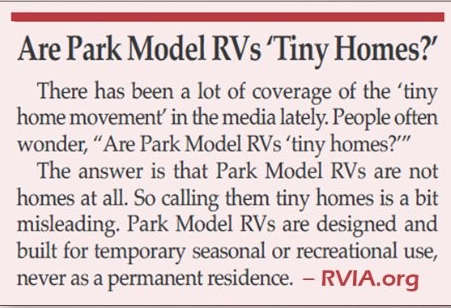
Most tiny house builders are building recreational vehicles ( RVs ) built to the NFPA 1192 Standard or the Park Model Standard, ANSI 119.5 for the ability to have them certified and registered, to get a Vin number and title and they are marketing the RVs as tiny homes or tiny houses.
The data plate, HUD label, or 3rd party insignia, identification and data plates would classify the home as a manufactured home, or modular, not a tiny house.
Zoning, Financing, Insurance, And Permitting: Tiny Houses On A Foundation, and Tiny Houses On Wheels cannot be broadly swept under the requirements and regulations of Manufactured Homes ( HUD) and Modular Homes because of specific requirements for each type of housing.
Modular Homes, Manufactured Homes, Accessory Dwelling Units ( ADUS), And Both Tiny Houses On Wheels And On Foundation All Have Unique Specific Allowances And Barriers To Zoning, Financing, Insurance, And Permitting Processes.
Tiny Houses On Wheels: At this time, there is not one unified industry standard that is recognized for tiny homes on wheels and each jurisdiction, bank, insurance agency, etc… could have a different definition and requirements, including size and if they are allowed as a dwelling.
Most tiny house builders are building recreational vehicles ( RVs ) built to the NFPA 1192 Standard or the Park Model Standard, ANSI 119.5 for the ability to have them certified and registered, to get a Vin number and title and they are marketing the RVs as tiny homes or tiny houses.
The Recreational Vehicle Industry ( RVIA) is opposed to the tiny house industry building to RV standards because RV standards are for temporary use and tiny houses are for long term housing.
All documentation, and the 3rd party insignia would classify this unit as an RV, not a tiny house on wheels officially.
Affordable Housing Efforts Threaten RV Industry: RV Industry Staff
‘In an effort to increase affordable housing, some policymakers across the country have begun to look to tiny homes as a solution. Unfortunately, these efforts have led some legislators, officials and other interest groups to attempt to co-opt RV and PMRV standards and definitions to use them for permanent-use tiny home standards. Washington state was the most active in this effort this year. ‘
‘Although both NFPA 1192 and ANSI A119.5 specifically state that these standards are for temporary-use vehicles, bills in Washington would have incorrectly defined all types of RVs and used the RV and PMRV standards to define permanent structures.’

ICC vs IAPMO vs ICC vs...One Solution?
I ran into this great article that is such a mirror of where we are at in this unnecessary standards war. The article was written by Jay Peters who is a Regulatory Strategist, Code and Standards Consultant , Product Compliance Specialist, and Expert Witness who has been employed by ICC and IAPMO.
” This week it was announced that ICC-ES filed a lawsuit in the United States District Court for the District of Columbia against IAPMO to stop what ICC purports to be an unauthorized use of ICC-ES materials and its knowing infringement of ICC-ES copyrights. IAPMO states that ICC’s accusations are unwarranted and their IAPMO UES stands by their process, reports, and rightful position in the marketplace as an alternative path to the ICC services.
As someone that has been intimately engaged and was game-fully employed by both of these organizations, I am truly sad to see this new lawsuit being filed – not because I care whether ICC or IAPMO wins, but because I realize that I no longer care anymore. I do care that the members and the industry that have been through this time and time again, will suffer….again and again. For that reason only, I care.
More Alike Than Different
Working as a senior staff member at both the International Code Council (ICC) and the International Association of Plumbing and Mechanical Officials (IAPMO) for more than a decade, I gained a great appreciation for both of their missions, members, stakeholders and contributions to the overall industry. For the most part, both operate a good business, with positive intent, taking the interests of their members into account while earning mega-revenues year after year.
Interestingly, and in contrary to what each highly competitive business likes to portray to the world, their organizations, businesses, revenue totals, stakeholders and their codes, are much more alike than different. Both the ICC and IAPMO have a very loyal membership. Both have governmental inspectors as their base member. Both develop plumbing and mechanical codes. Both create standards for products and systems installation. Both list, evaluate and certify products to meet standards and code provisions. Both educate, test and certify their inspectors to the code provisions. The similarities list goes on and on and on.
With all of this similitude as well as competition for business advantage in the same space, a conflict such as this was bound to happen. Of course it was going to happen. History always repeats itself.
Their business models revolve around their codes. It is a good model and an easy way to gain loyalty from their members. They create codes that bring safety to the built environment and place contractors and manufacturers on a level playing field with minimum requirements for their installations and product creations. Who could be opposed to providing greater public safety, locally, nationally and globally while driving innovation in the marketplace? Although the basic premise is the same, the method for earning from the codes differs.
Two Eight-Hundred-Pound Gorillas
Although they might not say it quite so bluntly, IAPMO specialized in the plumbing and mechanical codes and used their plumbing codes as a loss leader to gain income from their product testing and listing programs. Get the codes adopted by any method, even giving them away for free if necessary, and then require the products regulated in the code to be tested and listed. Why would a manufacturer go anywhere else for that service when their members are the same inspectors that inspect and approve the installations and the products in the marketplace?
A very good business model. Soon they became the 800 pound gorilla in the plumbing and mechanical product testing and listing jungle and earned tens of millions of dollars annually.
ICC on the other hand, was considered the code people. Their members created lots and lots of codes. Building codes, plumbing codes, existing building codes, residential codes, energy codes, green codes and more and more codes. They sold a lot of codes… a lot of codes, and then made ancillary products that fed off of the codes. Why go anywhere else for your codes when their members are the very experts in the building departments that create them and are responsible for the adoption and implementation of the codes. Another excellent business model. Soon they became the 800 pound gorilla in the code selling jungle and earned tens of millions of dollars annually.
Of course, two gorillas marking their boundaries and competing for food and affection in the same jungle will soon cross paths… sooner or later. The outcome from that encounter will prove to be painful for both combatants as well as their supporting family clans, regardless of who wins the battle.
Indifference Is The Worst
I can’t speak for the thousands of members, stakeholders, customers, employees and hundreds of dedicated experts that have worked hard to create the quality codes and standards for each organization. I can’t speak for the many manufacturers and clients that use both organizations’ services and spend millions to test, list and certify their products. As someone that has been through the intense battles that pit members against members, inspectors against inspectors, and coworkers against coworkers over the last twenty years, I can say that it has been intense and draining. I have been highly engaged, testified and staunchly defended both organizations at one time or another at regulatory hearings and membership meetings as a member and as senior staff.
I also went through the collaboration phase where the two organizations tried to join into a shared business unit and almost became a single organization that would have a shared membership and one vision and mission. That sounded awesome! The memberships and stakeholders were so tired of the ongoing conflict that they put aside their differences and tasked the collective leaderships to find a way to make it work and to satisfy all involved to stop the fighting once and for all. As one of the staff tasked with collaboration and divvying up the programs and even sharing our internal secrets to find that happy spot, it was rewarding.
We worked closely as one team and both sides had sincere and good intentions. After a lot of intense work and emotional strain, we were just moments away from code-world Shangri-La.
Then, the next thing we knew, the deal was killed. There was not a single person or side to blame and frankly it does not matter. It was back to the old ways. I can only speak for myself now and frankly, after gaining many code scars, I am absolutely indifferent. I am now numb to either side. The lawsuits and what might happen to the reputations of the organizations, oh well.
Choose a side… nope. In fact, indifference is probably worse than being an opponent. Indifference means that I don’t care enough to want to know any more about who is right or wrong. I have seen enough to know that it has gone on long enough and placing blame is meaningless. Please don’t misunderstand me. I am going to watch the train wreck and I am going to continue to help develop codes and standards, provide technical expertise, participate on committees and task groups, purchase codes, assist manufacturers to navigate the listing and testing process and purchase the services of IAPMO and ICC. I just refuse to get emotionally attached to either side.
Protecting Turfs, Lawsuits, Halting Progress, WHY? We Have The Same Goals
Related Blog Posts
ASTM Tiny House Subcommittee Goes To Ballot Under E6
COTCO Approves New Activity For Tiny House In ASTM International
ICC Objects To ASTM Tiny House On Wheels Standard
NH Rep. Jim Maggiore Endorses ASTM Tiny House Standards
COTCO Approves New Tiny House Committee
Jay Shafer Gets Behind ASTM Tiny House Standards

